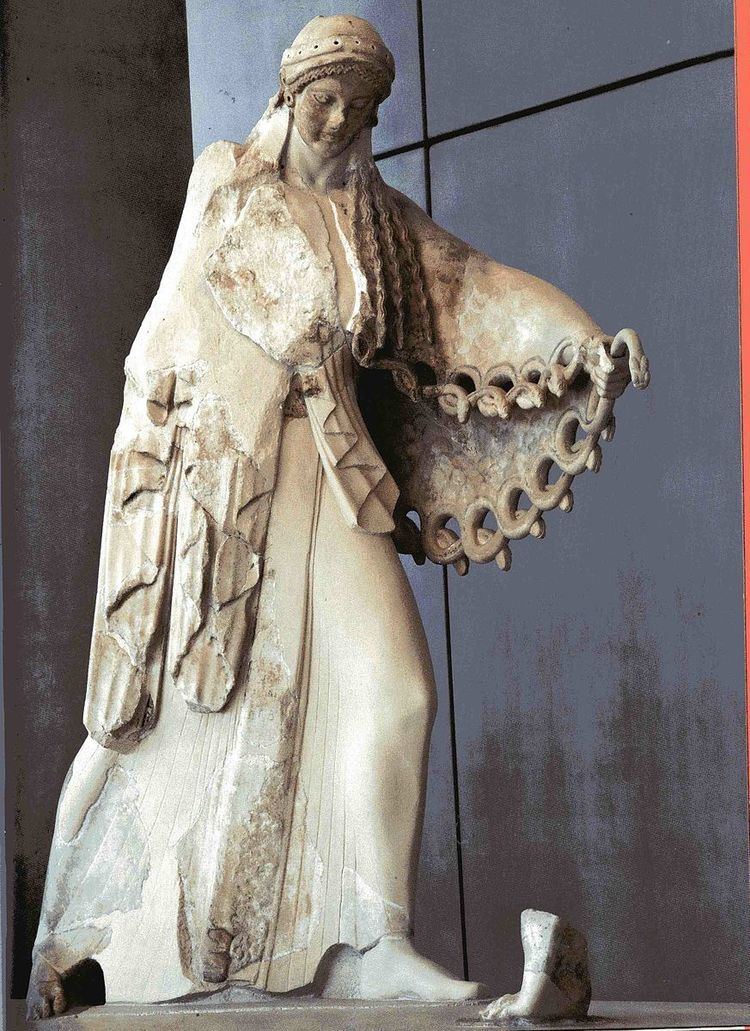Type Temple Location Athens, Greece Completed ca. 500 BC | Architectural style Ancient Greek Archaic Construction started ca. 525 BC | |
 | ||
Current tenants Museum of the Acropolis | ||
The Old Temple of Athena was an Archaic temple located on the Acropolis of Athens and built around 525-500 BC. Until its destruction by the Persians in 480 BC, it was the shrine of Athena Polias, the patron deity of the city of Athens. It was located at the centre of the Acropolis plateau, probably on the remains of a Mycenaean palace. The complex is sometimes described by the name "Dörpfeld foundations", after the archaeologist who first studied it. It was referred to as "Archaios neos" (Old temple) by the Greeks.
Contents
Plan
The foundations suggest the following basic description: The temple measured 21.3 by 43.15 m. It was surrounded by a peristasis of 6 by 12 columns. The difference between column axes was 4.04 m, narrowed by 0.31 m at the corners. The stylobate was slightly curved, whether this also applied to the superstructure remains unclear. In both the pronaos and opisthodomos, two columns stood between short antae. The cella was very short, in fact nearly square, and subdivided in three aisles by two rows of three columns each. It was followed by a pair of side-by-side rooms. The foundations were composed of various materials and constructed in varying techniques. While the load-bearing parts and internal supports were made of blue Acropolis limestone, the foundations of the surrounding peristasis were of poros limestone. The superstructure and decorative pieces also appear to have been made from a variety of materials, including 'poros' and Parian marble.
The pediments
Remains of one of the pediments have been found. They compose a gigantomachy, the struggle between gods and giants, eventually won by the Gods. The central figure of the struggle depicts the Goddess Athena wearing an aegis covered with scales and edged by snakes obtained from a monster she previously defeated. She is thought to hit a falling Giant, whose foot is the only remain. Another figure features a lying giant, whereas two side figures, once posed at the corners of the pediment, depict two more falling giants. Other rests ascribed to the temple include: entablature and sima of Parian marble, poros capitals with a steeper echinus, a marble frieze depicting a procession, and marble waterspouts in each of the four corners, shaped as lions' and rams' heads.
The xoanon
The cella of the temple contained the ancient xoanon or wooden statue of Athena, believed to have fallen from the sky. It was probably destroyed during the sack by the Persians in 480 BC.
Scholarly criticism
The reconstruction of the temple's architectural history has remained controversial until recently. Wilhelm Dörpfeld assumed that the original structure was a double temple in antis, dating to about 570 BC, lengthened and broadened by the addition of the peristasis under Peisistratus, between 529 and 520 BC. This idea led to a subdivision of the foundations into an inner smaller structure known as H-Architektur and assumed to be the oldest part of the building, followed by a structure still described as the "Old Temple of Athena", including the inner H-Architektur as well as the external peristasis.
More recently, scholars have attributed the older remains, initially attributed to the inner H-Architektur, to the close Hekatompedon temple, dating the temple of Athena Polias to the last third of the 6th century BC and identifying its dimensions with the entirety of the foundations excavated by Dörpfeld. The Old Temple of Athena Polias is often dated to circa 510/500 BC.
It remains controversial whether a partial restoration of the temple followed the Persian sack of 480 BC. Herodotus mentions a west-facing megaron on the Acropolis. This reference, as well as a structure listed in an inscription have been interpreted as evidence that the opisthodomus of the Old Temple remained in place through the fifth century. Xenophon states that the Old Temple of Athena burned down in 406/405 BC, but this might also refer to the Erechtheion, which had taken over the functions of the Old Temple and housed the xoanon. From the 4th century BC onwards, there are no possible references to the Old Temple; Pausanias was not aware of its existence.
